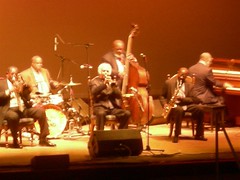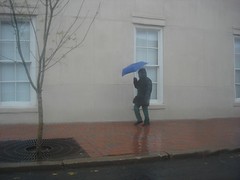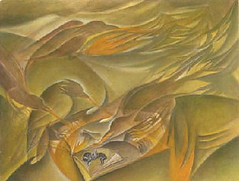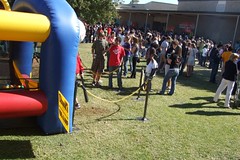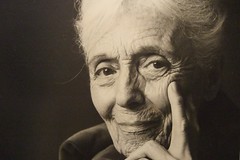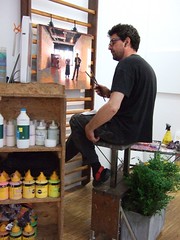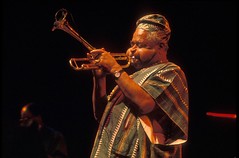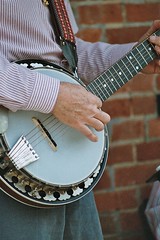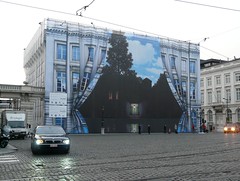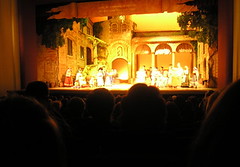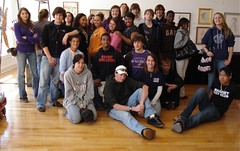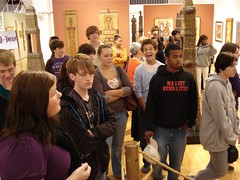Three of the greatest figures of early jazz:
a) Louis Amrmstrong
b) Duke Ellington
c) Django Rheinhardt
What's the best fellow - of the 3 above - to accompany these cues?
1. Born and raised in Washington, DC?
2. Great pianist as well as band leader and composer?
3. Loved smoking reefer?
4. Cut some great records in Chicago?
5. The tune "Take the A Train"?
6. The tune "Basin St Blues"?
7. Played his instrument with 2 fingers?
8. Married 4 times?
9. Born and raised in Belgium?
10. Wrote 2 biographies?
1. Duke
2. Duke
3. Satchmo
4.Satchmo
5. Duke
6. Satchmo
7. Django - the guitarist's hands were damaged in a fire.
8. Satchmo.
9. Django
10. Satchmo - he traveled with a typewriter because he loved writing letters. Armstrong wrote 2 autobiographies. The one that survives is My Life in New Orleans (avail in paperback).
Plus ca change, plas ca meme chose? French for " The more things change, the more they remain the same."
Friday, November 21, 2008
Monday, November 17, 2008
The Outsiders from the inside: review by Andrew Wood
What happens when you hear gunshots, see twenty guys fighting at once, and witness a burning building? Why, you must have been to see The Outsiders at Magnet High. The play ran last Wednesday through Friday to glorious review from the student body and staff.
The conflict of the play arises after Ponyboy and Johnny, Greasers, kill a young Social in self defense. The Socs are the richer "jet set."
The cast included some veterans of the Magnet stage as well as some very talented new-comers. Tyler Krieg played Ponyboy. This was his third Magnet show along with several other community theatre shows. The play also featured familiar faces such as Andrew Wood, Will Bowers, and Maddie Menefee. Some new faces included Freshman Adrian Gallegos and JZ Zavalydriga.
The shows strong leading cast was its greatest asset. However, there were some problems, mainly technical, that kept the show from being perfect. These included the voice-overs which seemed to keep the audience from making a conection with the main character. I also felt that more use could have been made of music to fill in the gaps caused by scene changes.
All in all, this show was top notch and is a good example of what we have come to expect from Magnet drama. Let's sit tight until the spring show, "A Funny Thing Happened On the Way to the Forum." Surely, it will be equally as good as the last shows. Keep it coming, Thespians!
- Utopia staff writer Andrew Wood
The conflict of the play arises after Ponyboy and Johnny, Greasers, kill a young Social in self defense. The Socs are the richer "jet set."
The cast included some veterans of the Magnet stage as well as some very talented new-comers. Tyler Krieg played Ponyboy. This was his third Magnet show along with several other community theatre shows. The play also featured familiar faces such as Andrew Wood, Will Bowers, and Maddie Menefee. Some new faces included Freshman Adrian Gallegos and JZ Zavalydriga.
The shows strong leading cast was its greatest asset. However, there were some problems, mainly technical, that kept the show from being perfect. These included the voice-overs which seemed to keep the audience from making a conection with the main character. I also felt that more use could have been made of music to fill in the gaps caused by scene changes.
All in all, this show was top notch and is a good example of what we have come to expect from Magnet drama. Let's sit tight until the spring show, "A Funny Thing Happened On the Way to the Forum." Surely, it will be equally as good as the last shows. Keep it coming, Thespians!
- Utopia staff writer Andrew Wood
Saturday, November 15, 2008
Quantum of Solace vocab from the NY Times review
Know your NY Times / James Bond vocab for the next quiz:
solace
quantum
sociocultural
hermeneutic
enigmatic
abysmal
cacophony
squalling
disharmonious
dramatic foil
pouty
semi-coherent
brooding
mopey
ciphers
flouting
libido
rakish
facade
somber
demeanor
suave
cynical
cold war
totalitarian humorlessness
paladin
pseudoserious
cosmopolitan
solace
quantum
sociocultural
hermeneutic
enigmatic
abysmal
cacophony
squalling
disharmonious
dramatic foil
pouty
semi-coherent
brooding
mopey
ciphers
flouting
libido
rakish
facade
somber
demeanor
suave
cynical
cold war
totalitarian humorlessness
paladin
pseudoserious
cosmopolitan
Thursday, November 13, 2008
The Entirely Visual Quiz 1
When you're sitting around watching a movie, tv show, webcast, etc., you will let your friends know that you've been to a good school, become a well-read person, by your ability to say "Picasso," or "Ramses II" at the appropriate visual cue.
Here's our first Visual Image Quiz.
Here's our first Visual Image Quiz.
Wednesday, November 12, 2008
Test on Thurs will address only visual items
Instead of the usual verbal questions designed to review the material we've consumed in fine arts class, let's try visuals.
Most of the material I've put on the class web site is classic. It is significant and timeless in terms of western society. Let's review it in an artful way.
Most of the material I've put on the class web site is classic. It is significant and timeless in terms of western society. Let's review it in an artful way.
Trompe l'oeil: a good idea for a blank wall (or canvas)
Jazz and modern art quiz
1. First city of jazz: __ __.
2. Second city of Jazz (and of the US in general): __ .
3. Third city to which the fathers of jazz - such as Joe Oliver and Louis Armstrong - relocated: __ __ .
4. Movement of impoverished black Americans from the farms of the Deep South to urban centers of Upper Midwest and Northeast: __ .
5. Approximate date for the birth of jazz: __ .
6. Name given to the place in New Orleans where slaves gathered on Sundays: __ __ .
7. Louisiana term for people of mixed ethnic background, esp. a mixture of French, Spanish, native American and Afro-Caribbean: __ .
8. Gens de couleur libre was a special ethnic category in NO. It indicated a person who was __ yet not a slave.
9. Another name for the French Quarter is Vieux Carre; it means: __ __ .
10. Parade dance practiced by New Orleanians at funerals: __ __ .
11. The founder of a drum manufacturing company (the Beatles used these) is credited with developing the trap drum set. The company? __ .
12. The key mechanical item in a drum set, or trap drum kit, is a foot pedal that enables the percussionist to sock the heck out of the __ __ .
13. The advent of the drum kit at the turn of the century enabled musical groups to reduce the percussion personnel from __ players to one.
14. The banjo originates with the ethnic group known as __ __.
15. Typically the 5-string banjo is used in playing __ music.
16. The 4-string banjo is commonly used in __ music.
17. A radical bend in the direction of his trumpet’s __ became part of the visual signature of Dizzie Gillespie.
18. Dizzie Gillespie was intimately associated with an intellectual type of jazz that emphasized cascades of notes played pell mell. This early modern jazz was called __.
19. "Break it down," "chops," "crib," "daddy-o," "dig" and similar words were jazz __, words that could indicate that you were an insider. Eventually these words went mainstream, such as the recent phrase “wanna give a shout-out to my man, Roscoe.”
20. A plectrum as in plectrum banjo, is a musical device better known as . . . a) mute b) capo c) resonator d) pick.
21. Gillespie, Ella Fitzgerald and other jazzers offered vocal improvisation with random vocables and syllables or without words at all. This is called __ singing.
22. The Vietnam War Memorial Wall mimics a wound in that it cuts into the turf - the viewer of the wall walks down a sidewalk which goes progressively deeper into the soil of the national mall. The design is based on a chevron, or shape of the letter _ .
23. The Vietnam War Memorial Wall was designed by a female and, in fact, an Asian-American. Her name is Maya __ .
24. Rushing water and island-like concrete blocks in the midst of the torrent are part of the design of the water gardens downtown in the city of __ __.
25. Freud's work with free association, dream analysis and the hidden unconscious was of the utmost importance to the artists known as __ in developing methods to liberate imagination.
26. Trompe l'oeil: A style of painting that presents an illusion of __ __ .
27. The French phrase trompe l'œil means to decieve the __ .
1. First city of jazz: __ __.
2. Second city of Jazz (and of the US in general): __ .
3. Third city to which the fathers of jazz - such as Joe Oliver and Louis Armstrong - relocated: __ __ .
4. Movement of impoverished black Americans from the farms of the Deep South to urban centers of Upper Midwest and Northeast: __ .
5. Approximate date for the birth of jazz: __ .
6. Name given to the place in New Orleans where slaves gathered on Sundays: __ __ .
7. Louisiana term for people of mixed ethnic background, esp. a mixture of French, Spanish, native American and Afro-Caribbean: __ .
8. Gens de couleur libre was a special ethnic category in NO. It indicated a person who was __ yet not a slave.
9. Another name for the French Quarter is Vieux Carre; it means: __ __ .
10. Parade dance practiced by New Orleanians at funerals: __ __ .
11. The founder of a drum manufacturing company (the Beatles used these) is credited with developing the trap drum set. The company? __ .
12. The key mechanical item in a drum set, or trap drum kit, is a foot pedal that enables the percussionist to sock the heck out of the __ __ .
13. The advent of the drum kit at the turn of the century enabled musical groups to reduce the percussion personnel from __ players to one.
14. The banjo originates with the ethnic group known as __ __.
15. Typically the 5-string banjo is used in playing __ music.
16. The 4-string banjo is commonly used in __ music.
17. A radical bend in the direction of his trumpet’s __ became part of the visual signature of Dizzie Gillespie.
18. Dizzie Gillespie was intimately associated with an intellectual type of jazz that emphasized cascades of notes played pell mell. This early modern jazz was called __.
19. "Break it down," "chops," "crib," "daddy-o," "dig" and similar words were jazz __, words that could indicate that you were an insider. Eventually these words went mainstream, such as the recent phrase “wanna give a shout-out to my man, Roscoe.”
20. A plectrum as in plectrum banjo, is a musical device better known as . . . a) mute b) capo c) resonator d) pick.
21. Gillespie, Ella Fitzgerald and other jazzers offered vocal improvisation with random vocables and syllables or without words at all. This is called __ singing.
22. The Vietnam War Memorial Wall mimics a wound in that it cuts into the turf - the viewer of the wall walks down a sidewalk which goes progressively deeper into the soil of the national mall. The design is based on a chevron, or shape of the letter _ .
23. The Vietnam War Memorial Wall was designed by a female and, in fact, an Asian-American. Her name is Maya __ .
24. Rushing water and island-like concrete blocks in the midst of the torrent are part of the design of the water gardens downtown in the city of __ __.
25. Freud's work with free association, dream analysis and the hidden unconscious was of the utmost importance to the artists known as __ in developing methods to liberate imagination.
26. Trompe l'oeil: A style of painting that presents an illusion of __ __ .
27. The French phrase trompe l'œil means to decieve the __ .
Ella Fitzgerald: scat singing, a magical type of jazz vocalizing
Ella Fitzgerald is generally considered one of the greatest scat singers in jazz history.[1]
In vocal jazz, scat singing is vocal improvisation with random vocables and syllables or without words at all. Scat singing gives singers the ability to sing improvised melodies and rhythms, to create the equivalent of an instrumental solo using their voice.
In vocal jazz, scat singing is vocal improvisation with random vocables and syllables or without words at all. Scat singing gives singers the ability to sing improvised melodies and rhythms, to create the equivalent of an instrumental solo using their voice.
Tuesday, November 11, 2008
Please enjoy a mandatory visit to see The Outsiders on WEd, Th or Fri
Drama and the evaluation thereof is essential to our study of fine arts. All fine arts students will be expected to attend and write a critical essay about the school play, The Outsiders.
Elements of the essay:
1. Very brief plot summary
2. Strengths of the stand-out actors; be specific: describe what they do.
3. Overall strengths of the performance; be specific; give examples.
4. Description and evaluation of the set and costumes.
5. Audience reaction.
6. Length and pace of the performance.
Elements of the essay:
1. Very brief plot summary
2. Strengths of the stand-out actors; be specific: describe what they do.
3. Overall strengths of the performance; be specific; give examples.
4. Description and evaluation of the set and costumes.
5. Audience reaction.
6. Length and pace of the performance.
Who are the Gypsies?
The Oxford English Dictionary (OED) states that a gypsy is a "member of a wandering race (by themselves called Romany), of Hindu origin, which first appeared in England about the beginning of the 16th c. and was then believed to have come from Egypt". The OED records the first usage of the word in English as 1514, says Wikipedia, with several more in the same century, and that both Edmund Spenser and William Shakespeare used the word.[1]
The word derives from the word for "Egyptian" in Latin, the same as the Spanish Gitano or the French Gitan. It emerged in Europe, in the 15th century, after their migration into the land of the Romani people (aka Roma) in that continent.[2] They received this name from the local people either because they spread in Europe from an area named Little Egypt, in Southern Balkans or because they fitted the European image of dark-skinned Egyptians skilled in witchcraft. During the sixteenth and seventeenth centuries it was written in various ways: Egipcian, Egypcian, 'gipcian, 'gypcian[3]. As the time elapsed, the notion of Gypsy evolved including other stereotypes, like nomadism, exoticism.[4]
The brilliant Belgian jazz guitarist Django Rheinhardt was a Gypsy.
The word derives from the word for "Egyptian" in Latin, the same as the Spanish Gitano or the French Gitan. It emerged in Europe, in the 15th century, after their migration into the land of the Romani people (aka Roma) in that continent.[2] They received this name from the local people either because they spread in Europe from an area named Little Egypt, in Southern Balkans or because they fitted the European image of dark-skinned Egyptians skilled in witchcraft. During the sixteenth and seventeenth centuries it was written in various ways: Egipcian, Egypcian, 'gipcian, 'gypcian[3]. As the time elapsed, the notion of Gypsy evolved including other stereotypes, like nomadism, exoticism.[4]
The brilliant Belgian jazz guitarist Django Rheinhardt was a Gypsy.
Bebop & modern jazz: trumpet player dizzie gillespie
John Birks "Dizzy" Gillespie (October 21, 1917 – January 6, 1993) was an American jazz trumpeter, bandleader, singer, and composer. He was born in Cheraw, South Carolina, the youngest of nine children. Dizzy's father was a local bandleader, so instruments were made available to Dizzy. He started to play the piano at the age of 4, says Wikipedia.
Together with Charlie Parker, he was a major figure in the development of bebop and modern jazz.
In addition to featuring in these epochal moments in bebop, he was instrumental in founding Afro-Cuban jazz, the modern jazz version of what early-jazz pioneer Jelly Roll Morton referred to as the "Spanish Tinge". Gillespie was a trumpet virtuoso and gifted improviser, building on the virtuoso style of Roy Eldridge but adding layers of harmonic complexity previously unknown in jazz.
In addition to his instrumental skills, Dizzy's beret and horn-rimmed spectacles, his scat singing, his bent horn, pouched cheeks and his light-hearted personality were essential in popularizing bebop, which was originally regarded as threatening and frightening music by many listeners raised on older styles of jazz.
Together with Charlie Parker, he was a major figure in the development of bebop and modern jazz.
In addition to featuring in these epochal moments in bebop, he was instrumental in founding Afro-Cuban jazz, the modern jazz version of what early-jazz pioneer Jelly Roll Morton referred to as the "Spanish Tinge". Gillespie was a trumpet virtuoso and gifted improviser, building on the virtuoso style of Roy Eldridge but adding layers of harmonic complexity previously unknown in jazz.
In addition to his instrumental skills, Dizzy's beret and horn-rimmed spectacles, his scat singing, his bent horn, pouched cheeks and his light-hearted personality were essential in popularizing bebop, which was originally regarded as threatening and frightening music by many listeners raised on older styles of jazz.
The instruments of jazz: the African-American-developed banjo
The banjo is a stringed instrument developed by enslaved Africans in the United States, adapted from several African instruments.[1] The name banjo commonly is thought to be derived from the Kimbundu term mbanza. Some etymologists derive it from a dialectal pronunciation of "bandore", though recent research suggests that it may come from a Senegambian term for the bamboo stick used for the instrument's neck, says Wikipedia.
The banjo can be played in several styles and is used in various forms of music. American old-time music typically uses the five-string open back banjo. It is played in a number of different styles, the most common of which are called clawhammer (or "claw-hammer") and frailing, characterised by the use of a downward rather than upward motion when striking the strings with the fingers. Banjo picks are usually inserted onto the fingers for a smoother playing.
The plectrum banjo has four strings, lacking the shorter fifth drone string, and around 22 frets. As the name suggests, it is usually played with a guitar-style pick (that is, a single one held between thumb and forefinger), unlike the five-string banjo, which is either played with a thumbpick and two fingerpicks, or with bare fingers.
The plectrum banjo evolved out of the five-string banjo, to cater to styles of music involving strummed chords.
The tenor banjo has become a standard instrument for Irish traditional music. The tenor banjo was also a common rhythm instrument in early jazz and dance bands throughout the 1920s and 1930s. Its volume and timbre suited early jazz (and jazz-influenced popular music styles) and could both compete with other instruments (such as brass instruments and saxophones) and be heard clearly on acoustic recordings. However, as the guitar gained in popularity in the 1930s, the tenor banjo moved out of mainstream jazz and popular music finding a place in traditional jazz and Dixieland jazz.
The banjo can be played in several styles and is used in various forms of music. American old-time music typically uses the five-string open back banjo. It is played in a number of different styles, the most common of which are called clawhammer (or "claw-hammer") and frailing, characterised by the use of a downward rather than upward motion when striking the strings with the fingers. Banjo picks are usually inserted onto the fingers for a smoother playing.
The plectrum banjo has four strings, lacking the shorter fifth drone string, and around 22 frets. As the name suggests, it is usually played with a guitar-style pick (that is, a single one held between thumb and forefinger), unlike the five-string banjo, which is either played with a thumbpick and two fingerpicks, or with bare fingers.
The plectrum banjo evolved out of the five-string banjo, to cater to styles of music involving strummed chords.
The tenor banjo has become a standard instrument for Irish traditional music. The tenor banjo was also a common rhythm instrument in early jazz and dance bands throughout the 1920s and 1930s. Its volume and timbre suited early jazz (and jazz-influenced popular music styles) and could both compete with other instruments (such as brass instruments and saxophones) and be heard clearly on acoustic recordings. However, as the guitar gained in popularity in the 1930s, the tenor banjo moved out of mainstream jazz and popular music finding a place in traditional jazz and Dixieland jazz.
The instruments of jazz: trap set of drums
Drum sets were first developed due to financial and space considerations in theaters where drummers were encouraged to cover as many percussion parts as possible, says Wikipedia. Up until then, drums and cymbals were played separately in military and orchestral music settings. Initially, drummers played the bass and snare drums by hand, then in the 1890s they started experimenting with footpedals to play the bass drum. William F. Ludwig made the bass drum pedal system workable in 1909, paving the way for the modern drum kit.
By World War I drum kits were characterized by very large marching bass drums and many percussion items suspended on and around it, and they became a central part of jazz music. Hi-hat stands appeared around 1926.
By World War I drum kits were characterized by very large marching bass drums and many percussion items suspended on and around it, and they became a central part of jazz music. Hi-hat stands appeared around 1926.
Monday, November 10, 2008
Fort Worth Water Gardens, a vivid example of public art
Designed by noted New York architects Philip Johnson and John Burgee, the Ft Worth Water Garden was dedicated to the city by the Amon G. Carter Foundation, says Wikipedia.
The urban park is frequently billed as a "cooling oasis in the concrete jungle" of downtown. Its focal points are three pools of water and a terraced knoll, which helps to shield the park from adjacent Interstate 30. The quiet meditation pool is encircled with trees and features a flat, still plane of water that cascades almost 90 degrees down to a sunken walkway. The aerating pool features multiple spray fountains.
The main attraction of the Water Gardens is the active pool which has water cascading 38 feet (11 m) down terraces and steps into a small pool at the bottom. It also has over 500 species of plants and trees throughout the park.
The urban park is frequently billed as a "cooling oasis in the concrete jungle" of downtown. Its focal points are three pools of water and a terraced knoll, which helps to shield the park from adjacent Interstate 30. The quiet meditation pool is encircled with trees and features a flat, still plane of water that cascades almost 90 degrees down to a sunken walkway. The aerating pool features multiple spray fountains.
The main attraction of the Water Gardens is the active pool which has water cascading 38 feet (11 m) down terraces and steps into a small pool at the bottom. It also has over 500 species of plants and trees throughout the park.
Sunday, November 9, 2008
Public art: the Vietnam Memorial Wall, Washington DC, designed by architect-artist Maya Lin
In 1981, at age 21 and while still an undergraduate, Maya Lin won a public design competition for the Vietnam Veterans Memorial. The black cut-stone masonry wall, with the names of fallen soldiers carved into its face as requested by the families of the casualties, officially opened to the public on November 13, 1982. The wall is granite and V-shaped, with one side pointing to the Lincoln Memorial and the other to the Washington Monument.
Lin's conception was to create an opening or a wound in the earth to symbolize the gravity of the loss of the soldiers. The design was originally controversial but has since been much acclaimed and is visited by hundreds of thousands of tourists every year. It has also become an important pilgrimage site for relatives and friends of the American military casualties in Vietnam, and personal tokens and mementos are left at the wall daily in their memory.[4][5]
Lin believes that if the competition had not been "blind", with designs submitted by number instead of name, she "never would have won." Some groups criticized the memorial because of its non-traditional design, but Lin successfully defended her design in front of the United States Congress. Eventually a compromise was reached and a bronze statue of a group of soldiers and an American flag was placed off to one side of the monument.[3]
Lin's conception was to create an opening or a wound in the earth to symbolize the gravity of the loss of the soldiers. The design was originally controversial but has since been much acclaimed and is visited by hundreds of thousands of tourists every year. It has also become an important pilgrimage site for relatives and friends of the American military casualties in Vietnam, and personal tokens and mementos are left at the wall daily in their memory.[4][5]
Lin believes that if the competition had not been "blind", with designs submitted by number instead of name, she "never would have won." Some groups criticized the memorial because of its non-traditional design, but Lin successfully defended her design in front of the United States Congress. Eventually a compromise was reached and a bronze statue of a group of soldiers and an American flag was placed off to one side of the monument.[3]
Friday, November 7, 2008
Second Line: the street dance that accompanies hot jazz music in New Orleans
Second line is a tradition in brass band parades in New Orleans, Louisiana. The term is also used for an associated traditional dance style, notes wikipedia.
Music is an important part of most public events in traditional New Orleans culture. Processions with music include the periodic parades of benevolent societies, social aid & pleasure clubs, such as Zulu, other Carnival krewes, and of course the famous funerals with music, often called "jazz funerals".
The "first line" of a funeral consisted of the people who were an integral part of the ceremony, such as the members of the club or krewe, or family and friends of the deceased. The "second line" originally referred to people who were attracted to the music.
To follow such processions because one enjoyed the music came to be known as to "second line" or to be "second lining." Uninhibited dancing at processions also came to be called second lining.
For uninihibited dancing, see the push-up like, worm-like undulating dance move performed by men on the dance floor or pavement called "popping a gator."
Thus we see that the roots of jazz are in a type of dance music.
Music is an important part of most public events in traditional New Orleans culture. Processions with music include the periodic parades of benevolent societies, social aid & pleasure clubs, such as Zulu, other Carnival krewes, and of course the famous funerals with music, often called "jazz funerals".
The "first line" of a funeral consisted of the people who were an integral part of the ceremony, such as the members of the club or krewe, or family and friends of the deceased. The "second line" originally referred to people who were attracted to the music.
To follow such processions because one enjoyed the music came to be known as to "second line" or to be "second lining." Uninhibited dancing at processions also came to be called second lining.
For uninihibited dancing, see the push-up like, worm-like undulating dance move performed by men on the dance floor or pavement called "popping a gator."
Thus we see that the roots of jazz are in a type of dance music.
Thursday, November 6, 2008
European Fine Arts Quiz
European Fine Arts Magnet / Trudeau
1. This type of art (or literature) includes the element of surprise, unexpected juxtapositions and non sequitur (“does not follow”): ____ .
2. Clyde Connnell did most of her work in Shreveport and at Lake Bistineau but she was born and raised on a plantation in Texas. T / F
3. Name the distinctive indie / pop group from Iceland in which the guitarist uses a cello bow and sings in an incomprehensible language. a) Radiohead b) Sigur Ros
c) Tetrafusion d) Damien Hirst.
4. American photographer known for his large-scale, highly stylized black and white portraits, photos of flowers and naked men. Robert ___ .
5. In 1924, in collaboration with Man Ray, the French artist
Fernand __ produced and directed the iconic and Futurism-influenced film, Ballet Mécanique (Mechanical Ballet). Neither abstract nor narrative, it is a series of images of a woman's lips and teeth, close-up shots of ordinary objects, and repeated images of human activities and machines in rhythmic movement.
6. René François ____ (1898 - 1967) was a Belgian surrealist artist. Popular interest in his work rose in the 1960s. His imagery has influenced pop, minimalist and conceptual art.
7. ____ism describes movements in various forms of art and design, especially visual art and music, where the work is stripped down to its most fundamental features. Architect Ludwig Mies van der Rohe adopted the motto "Less is more" to describe his aesthetic tactic of arranging the numerous necessary components of a building to create an impression of extreme simplicity.
8. The history of the ownership of an object, especially when documented or authenticated. Used in regards artworks, antiques, and books: a) provenance
b) scrutiny c) faux marbre d) dilettante.
9. The region known as the Cote d’Azur lies alongside the _(geographical feature)_ in southern France.
10. The _____ are members of the upper or merchant class, whose status or power comes from employment, education, and wealth.
1. This type of art (or literature) includes the element of surprise, unexpected juxtapositions and non sequitur (“does not follow”): ____ .
2. Clyde Connnell did most of her work in Shreveport and at Lake Bistineau but she was born and raised on a plantation in Texas. T / F
3. Name the distinctive indie / pop group from Iceland in which the guitarist uses a cello bow and sings in an incomprehensible language. a) Radiohead b) Sigur Ros
c) Tetrafusion d) Damien Hirst.
4. American photographer known for his large-scale, highly stylized black and white portraits, photos of flowers and naked men. Robert ___ .
5. In 1924, in collaboration with Man Ray, the French artist
Fernand __ produced and directed the iconic and Futurism-influenced film, Ballet Mécanique (Mechanical Ballet). Neither abstract nor narrative, it is a series of images of a woman's lips and teeth, close-up shots of ordinary objects, and repeated images of human activities and machines in rhythmic movement.
6. René François ____ (1898 - 1967) was a Belgian surrealist artist. Popular interest in his work rose in the 1960s. His imagery has influenced pop, minimalist and conceptual art.
7. ____ism describes movements in various forms of art and design, especially visual art and music, where the work is stripped down to its most fundamental features. Architect Ludwig Mies van der Rohe adopted the motto "Less is more" to describe his aesthetic tactic of arranging the numerous necessary components of a building to create an impression of extreme simplicity.
8. The history of the ownership of an object, especially when documented or authenticated. Used in regards artworks, antiques, and books: a) provenance
b) scrutiny c) faux marbre d) dilettante.
9. The region known as the Cote d’Azur lies alongside the _(geographical feature)_ in southern France.
10. The _____ are members of the upper or merchant class, whose status or power comes from employment, education, and wealth.
Wednesday, November 5, 2008
Surrealism: the trompe l'oeil of the Magritte museum...
Surrealism[1] is a cultural movement that began in the early-1920s, and is best known for the visual artworks and writings of the group members, says Wikipedia.
Surrealist works feature the element of
surprise,
unexpected juxtapositions and
non sequitur;
however many Surrealist artists and writers regard their work as an expression of the philosophical movement first and foremost, with the works being an artifact.
Leader André Breton was explicit in his assertion that Surrealism was above all a revolutionary movement.
Surrealism developed out of the Dada activities of World War I and the most important center of the movement was Paris. From the 1920s on, the movement spread around the globe, eventually affecting the visual arts, literature, film, and music, of many countries and languages, as well as political thought and practice, and philosophy and social theory.
Freud's work with free association, dream analysis and the hidden unconscious was of the utmost importance to the Surrealists in developing methods to liberate imagination. However, they embraced idiosyncrasy, while rejecting the idea of an underlying madness or darkness of the mind. (Later the idiosyncratic Salvador Dalí explained it as: "There is only one difference between a madman and me. I am not mad."[4])
The group aimed to revolutionize human experience, including its personal, cultural, social, and political aspects, by freeing people from what they saw as false rationality, and restrictive customs and structures.
Surrealist works feature the element of
surprise,
unexpected juxtapositions and
non sequitur;
however many Surrealist artists and writers regard their work as an expression of the philosophical movement first and foremost, with the works being an artifact.
Leader André Breton was explicit in his assertion that Surrealism was above all a revolutionary movement.
Surrealism developed out of the Dada activities of World War I and the most important center of the movement was Paris. From the 1920s on, the movement spread around the globe, eventually affecting the visual arts, literature, film, and music, of many countries and languages, as well as political thought and practice, and philosophy and social theory.
Freud's work with free association, dream analysis and the hidden unconscious was of the utmost importance to the Surrealists in developing methods to liberate imagination. However, they embraced idiosyncrasy, while rejecting the idea of an underlying madness or darkness of the mind. (Later the idiosyncratic Salvador Dalí explained it as: "There is only one difference between a madman and me. I am not mad."[4])
The group aimed to revolutionize human experience, including its personal, cultural, social, and political aspects, by freeing people from what they saw as false rationality, and restrictive customs and structures.
Tuesday, November 4, 2008
Yeero Yeero, Shreveport, earns another review of the food and ambience
Yeero! Yeero! could be one of the most easily overlooked restaurants in town. Painted white and blue like the Greek flag, the eatery, near the corner of Youree and Southfield, started as a drive-through, and it still looks like that's all it is from the outside. However, the inside of Yeero! Yeero! has the feel of an upscale restaurant: marble floors, pressed tin ceiling, ornate tables and chairs. The leather-bound menus contain a host of Greek sandwiches and dishes, which are the real reason for the crowd. My dining experience was quite an enjoyable one. I started with an order of spanakopita, or spinach pie. The spinach itself was a little bland, but the buttery dough makes it much easier to eat your greens. For my entrée, I ordered moussaka, a sort of Greek lasagna. It was plentiful in flavor. The dish was served with a side of fresh, hot, wonderfully soft pita bread. Even though the portion wasn't overwhelming, I couldn't finish it. Throughout the meal, my glass was kept full and the ambiance allowed us to forget I was next to one of the busiest intersections in Shreveport. As I finished, the baklava sounded tempting, but I was too stuffed. I'll have to remember it next time, because I'm sure I'll return.
- Martin Black
- Martin Black
Monday, November 3, 2008
Blues & jazz develop along the trail of the Black American dispora
As Black Americans left the field hand work of Louisiana, Mississippi and other southern states, they took their culture and went north. In cities such as St Louis and Chicago they found factory work and a different life.
The story of Louis Armstrong and Joe King Oliver was to leave New Orleans and go to Chicago - where they were much in demand for performing and recording.
Eventually both pushed on to NYC, the Big Apple. It became the center of Jazz for decades.
The word diaspora (dispersal) also applies to the Jews (Palestine to Europe, etc), to Africans in the Atlantic slave trade and to the Irish.
The story of Louis Armstrong and Joe King Oliver was to leave New Orleans and go to Chicago - where they were much in demand for performing and recording.
Eventually both pushed on to NYC, the Big Apple. It became the center of Jazz for decades.
The word diaspora (dispersal) also applies to the Jews (Palestine to Europe, etc), to Africans in the Atlantic slave trade and to the Irish.
Sunday, November 2, 2008
Shreveport Opera: Cavalleria Rusticana and Pagliacci are timeless works
Excellent summaries and comparisons, Andrew. I'm putting the essay on fineartsmagnet so the class can review it. 10/10 -robert trudeau 11/2/08 4:19 PM
Tragedy Within Comedy
Cavalleria Rusticana and Pagliacci are two timeless operas that have remained popular even to this day. They have many things in common, such as the time of the setting, the writer, and the time of year of the setting: Easter.
Both operas tell the stories of passionate – and unfaithful – lovers. In Cavalleria Rusticana, the character of Turiddu slept with Santuzza in order to make is ex-fiancé, Lola, jealous. And jealous she became . . . . Santuzza cannot stand the shunning she is receiving from Turiddu. So, to take her revenge, she tells Lola’s husband, Alfio, about Turiddu’s affair. In his anger, Alfio challenges Turiddu to a duel which ends in Turiddu’s death. The no only leaves him dead, but it also leaves Santuzza without a father for her child and Lucia without her beloved son.
Pagliacci is about a traveling acting troupe. As they enter a small town to perform, two different affairs are unveiled; Canio’s wife, Nedda, is cheating on him with Silvio. The other affair is quite ironic. Canio and Nedda’s characters in the play within the play are also unfaithful. Nedda’s character has taken a lover. While the performance goes on, the actors begin to argue. Canio demands to be told the name of Nedda’s lover. The audience does not realize, at first, that they are not acting. Silvo runs to the stage to rescue his love, but Canio stabs both of them and ends with the famous line, “La Commedia è finita!” – meaning, “the play is over.”
Both operas show to darker side of love. What happens when you betray the one person who trusted you the most? As we see from these shows, it usually ends in tragedy. That, I would say, is the reverberating theme of these musical masterpieces.
Tragedy Within Comedy
Cavalleria Rusticana and Pagliacci are two timeless operas that have remained popular even to this day. They have many things in common, such as the time of the setting, the writer, and the time of year of the setting: Easter.
Both operas tell the stories of passionate – and unfaithful – lovers. In Cavalleria Rusticana, the character of Turiddu slept with Santuzza in order to make is ex-fiancé, Lola, jealous. And jealous she became . . . . Santuzza cannot stand the shunning she is receiving from Turiddu. So, to take her revenge, she tells Lola’s husband, Alfio, about Turiddu’s affair. In his anger, Alfio challenges Turiddu to a duel which ends in Turiddu’s death. The no only leaves him dead, but it also leaves Santuzza without a father for her child and Lucia without her beloved son.
Pagliacci is about a traveling acting troupe. As they enter a small town to perform, two different affairs are unveiled; Canio’s wife, Nedda, is cheating on him with Silvio. The other affair is quite ironic. Canio and Nedda’s characters in the play within the play are also unfaithful. Nedda’s character has taken a lover. While the performance goes on, the actors begin to argue. Canio demands to be told the name of Nedda’s lover. The audience does not realize, at first, that they are not acting. Silvo runs to the stage to rescue his love, but Canio stabs both of them and ends with the famous line, “La Commedia è finita!” – meaning, “the play is over.”
Both operas show to darker side of love. What happens when you betray the one person who trusted you the most? As we see from these shows, it usually ends in tragedy. That, I would say, is the reverberating theme of these musical masterpieces.
Jazz in New Orleans, Chicago and NYC
Whether to go to Shreveport Opera for Pagliacci or to Centenary College's amphitheater for a performance by Tetrafusion is the question for next week. They both take place Sat, Nov 8.
Btw, Caddo Schools take a break on Tues, Nov 4, for the presidential election.
This week we will finish student reports on 20th century artists and listen to brief reports on jazz music.
Friday we worked on specific words of description so as to make essays clearer. The discussion was based on the essays about visiting Artspace.
The geography of jazz begins with New Orleans. It travels up the Mississippi via steam to Chicago, to the South Side. The music was part of the Black diaspora from the poverty-ridden fields of the rural South to the factories and tenement buildings of the big cities.
Chicago and NYC were the places where the first jazz records were cut. The multi-cultural life of New Orleans fostered creativity in performance but did not produce the business organizations or recording studios that would enable the city to capitalize on local talent. To some extent that remains part of the character of New Orleans.
Btw, there Was a time when New Orleans made a slew of hit records. It was the late 1950's and the R n B hits came from people like Fats Domino ("I'm Walkin'") and Shirley & Lee ("Let the Good Times Roll").
Satchmo was born and raised in the Crescent City but recorded his amazing and classic performances in Chicago and NYC.
Do you remember the word shibboleth? It means vocab that is peculiar to a particular group. Such as a teen shibboleth like "deface," or "faux five." Satchmo used slanguage from the black community in his conversations and songs. "Break it down," "chops," "crib," "daddy-o," "dig" and similar words became jazz shibboleths.
Btw, Caddo Schools take a break on Tues, Nov 4, for the presidential election.
This week we will finish student reports on 20th century artists and listen to brief reports on jazz music.
Friday we worked on specific words of description so as to make essays clearer. The discussion was based on the essays about visiting Artspace.
The geography of jazz begins with New Orleans. It travels up the Mississippi via steam to Chicago, to the South Side. The music was part of the Black diaspora from the poverty-ridden fields of the rural South to the factories and tenement buildings of the big cities.
Chicago and NYC were the places where the first jazz records were cut. The multi-cultural life of New Orleans fostered creativity in performance but did not produce the business organizations or recording studios that would enable the city to capitalize on local talent. To some extent that remains part of the character of New Orleans.
Btw, there Was a time when New Orleans made a slew of hit records. It was the late 1950's and the R n B hits came from people like Fats Domino ("I'm Walkin'") and Shirley & Lee ("Let the Good Times Roll").
Satchmo was born and raised in the Crescent City but recorded his amazing and classic performances in Chicago and NYC.
Do you remember the word shibboleth? It means vocab that is peculiar to a particular group. Such as a teen shibboleth like "deface," or "faux five." Satchmo used slanguage from the black community in his conversations and songs. "Break it down," "chops," "crib," "daddy-o," "dig" and similar words became jazz shibboleths.
Descriptive vocab . . .
pensive brunette
black cotton hoodie
narrow, gray-brown towers
open-mouthed grin
paper and fabric wall hangings
brightly-lighted museum
nubbly surface
arms folded across the chest
8-foot tall totems
sweeping bangs
brown paper and rusted iron
iron oxide stains
fragmented human forms
hat in hand
14 teens
downcast eyes
polished wooden floors
pastel walls
anthropomorphic stelae
Remember to enhance your writing by using specifically descriptive words. General and vague descriptions are the sign of a writer who needs more instruction and maturation.
black cotton hoodie
narrow, gray-brown towers
open-mouthed grin
paper and fabric wall hangings
brightly-lighted museum
nubbly surface
arms folded across the chest
8-foot tall totems
sweeping bangs
brown paper and rusted iron
iron oxide stains
fragmented human forms
hat in hand
14 teens
downcast eyes
polished wooden floors
pastel walls
anthropomorphic stelae
Remember to enhance your writing by using specifically descriptive words. General and vague descriptions are the sign of a writer who needs more instruction and maturation.
Subscribe to:
Posts (Atom)
